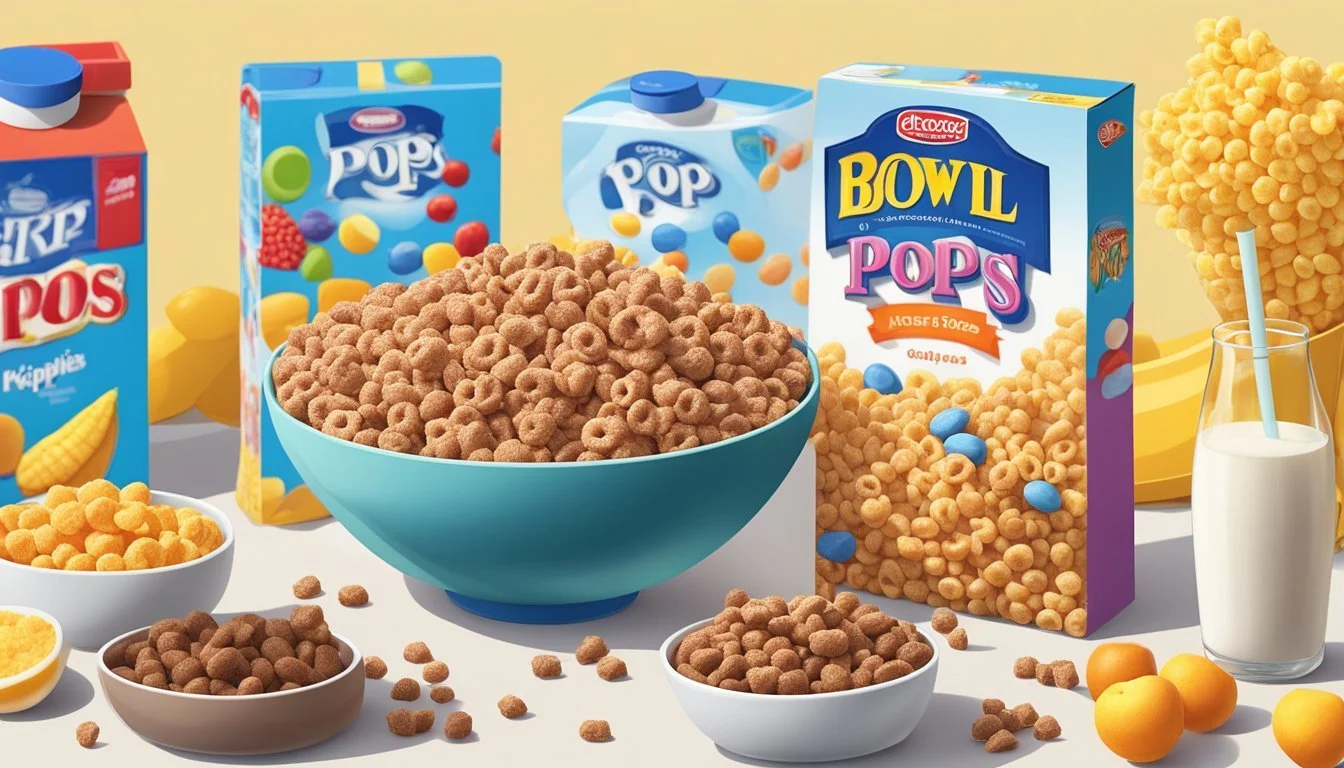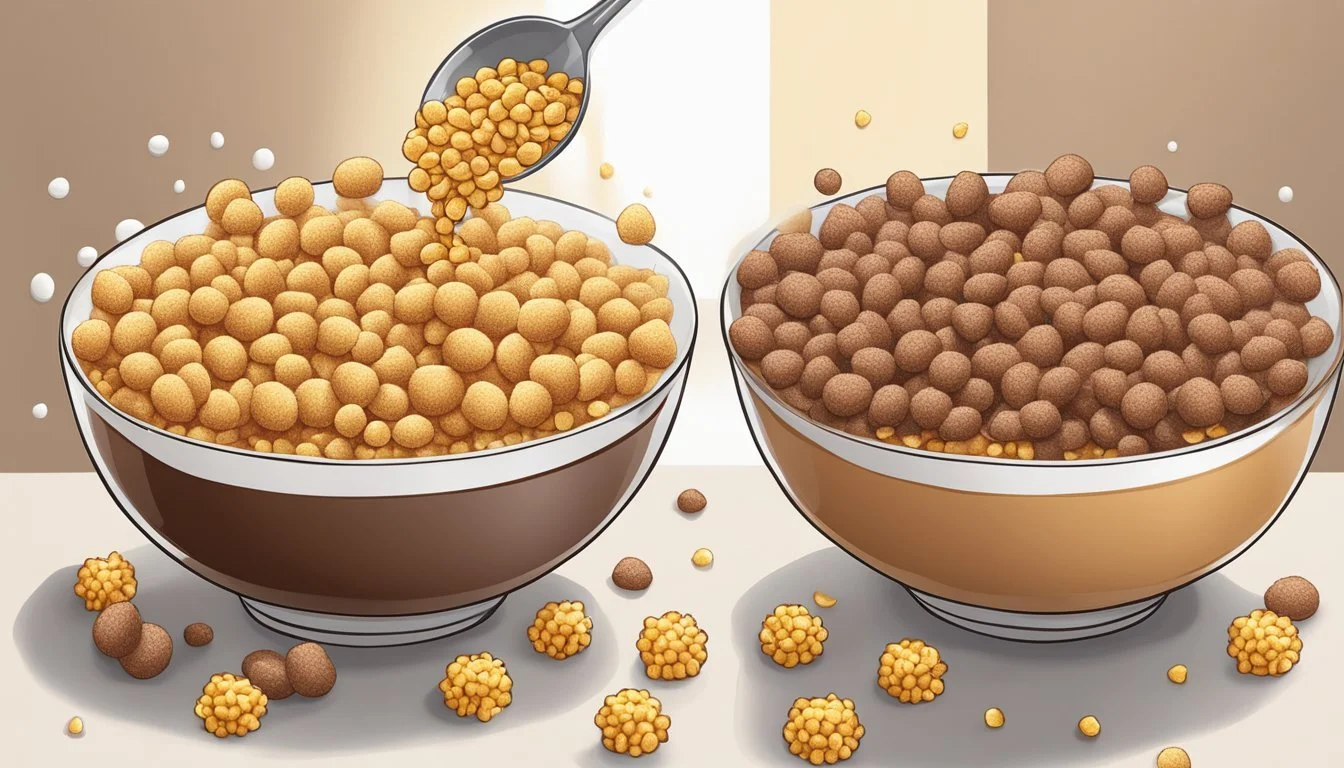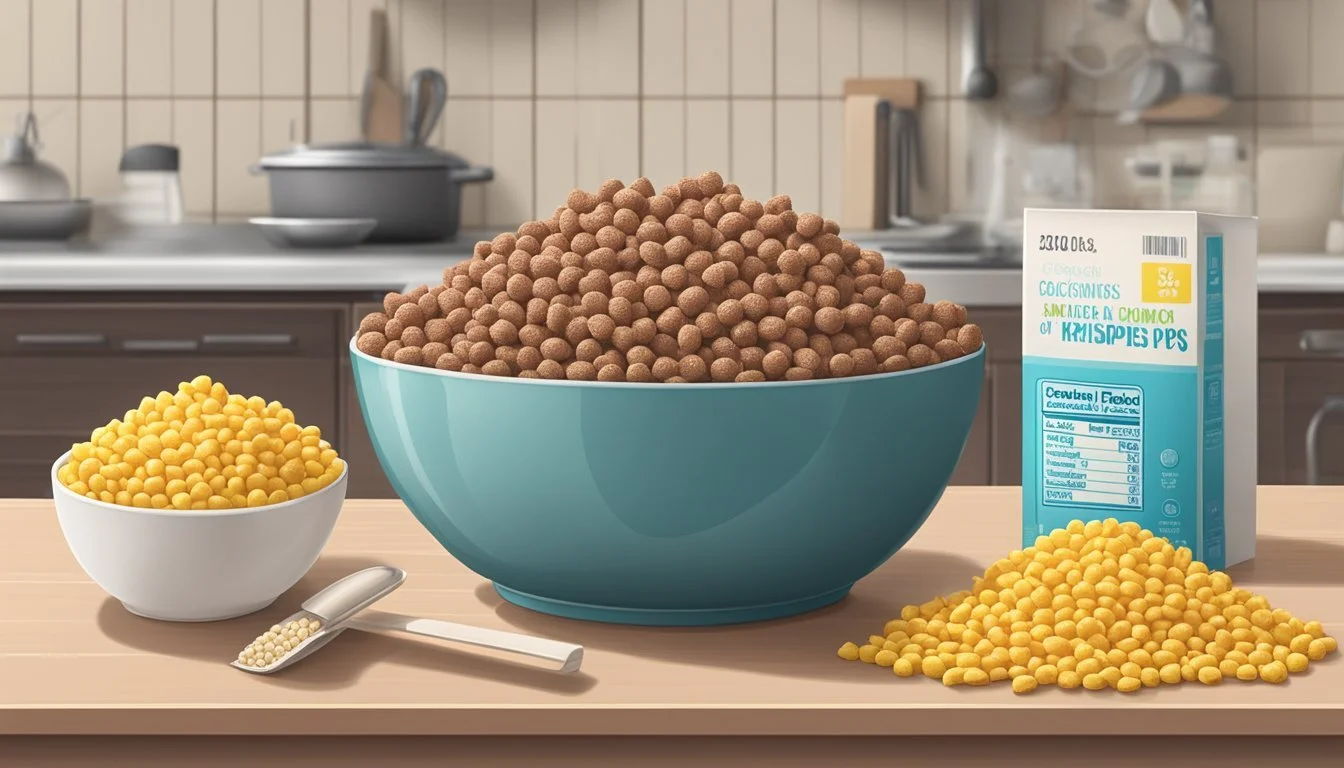Cocoa Krispies vs Corn Pops
Nutritional Comparison and Taste Test
This Article is Part of Our Breakfast Cereal Guide with Details on Cocoa Krispies Nutrition and Corn Pops Nutrition
When it comes to breakfast choices, two popular cereals often come to mind: Cocoa Krispies and Corn Pops. Cocoa Krispies, with their distinct chocolate flavor and crunchy texture, provide a sweet start to the day, appealing especially to chocolate lovers. Corn Pops, on the other hand, offer a lighter corn flavor with a satisfying crunch that many find hard to resist.
Nutritionally, these cereals provide different benefits and drawbacks. Cocoa Krispies tend to have higher sugar content compared to Corn Pops, which might be a concern for those watching their sugar intake. Both cereals, however, can fit into a balanced diet when eaten in moderation.
For those seeking a nostalgic breakfast experience, the choice might rely on personal preference for taste and texture. Whether you're reaching for the rich, chocolatey goodness of Cocoa Krispies or the simple, sweet crunch of Corn Pops, each cereal brings something unique to the breakfast table.
History and Origin
Cocoa Krispies and Corn Pops are both products of WK Kellogg Co, initially known as Kellogg's. These cereals have distinct histories that reflect the evolution of breakfast trends.
Cocoa Krispies, also known by various names like Choco Krispis and Coco Pops depending on the region, made their debut as a cocoa-flavored variety of Rice Krispies. It is known for containing real chocolate. The availability includes boxed cereal and a snack bar form.
Corn Pops, described as "crunchy, sweetened popped-up corn cereal," were first introduced in 1950. Originally, they were named "Corn Pops." In 1951, the name changed to "Sugar Corn Pops," and later became simply "Sugar Pops."
The product names evolved over the years. By 1978, the name reverted to "Sugar Corn Pops." From 1984 onwards, the cereal has been known as Corn Pops.
Corn Pops hold a notable place in cereal history as the first new cereal post-World War II by Kellogg's. They also gained popularity by sponsoring "The Adventures of Wild Bill Hickok" radio and television show.
Both cereals reflect the innovation and marketing strategies of Kellogg's over the decades, showcasing their enduring appeal in the breakfast cereal market.
General Nutritional Profile
Cocoa Krispies and Corn Pops offer differing nutritional benefits and considerations. This section details their key nutritional components, including calories, macronutrients, vitamins, minerals, fiber, protein, and healthy fats.
Calories and Macronutrients
Cocoa Krispies contain approximately 120 calories per serving, while Corn Pops have around 110 calories. These cereals provide energy primarily through carbohydrates.
Cocoa Krispies:
Calories: 120
Carbohydrates: 27g
Protein: 1g
Fat: 1g (0.5g saturated fat)
Corn Pops:
Calories: 110
Carbohydrates: 26g
Protein: 1.3g
Fat: 0.1g (0.01g saturated fat)
Vitamins and Minerals Content
Cocoa Krispies are richer in several vitamins and minerals compared to Corn Pops. They offer significant amounts of Vitamin B12, iron, Vitamin A, Vitamin B6, and zinc. Corn Pops provide essential nutrients but in lower quantities.
Cocoa Krispies:
Vitamin B12: 200% DV
Iron: 45% DV
Vitamin A: 15% DV
Vitamin B6: 15% DV
Zinc: 15% DV
Corn Pops:
Vitamin A: 10% DV
Vitamin C: 10% DV
Iron: 20% DV
Calcium: 0% DV
Potassium: 10mg
Fiber, Protein, and Healthy Fats
Neither Cocoa Krispies nor Corn Pops are significant sources of dietary fiber or protein. Cocoa Krispies have slightly more fiber due to the whole grains used in their production.
Cocoa Krispies:
Fiber: 2g
Protein: 1g
Healthy Fats: Minimal
Corn Pops:
Fiber: 0.7g
Protein: 1.3g
Healthy Fats: Minimal
Both cereals contain low amounts of healthy fats and minimal saturated fat. While they can be part of a balanced diet, it's important to supplement them with other nutrient-dense foods.
Ingredients Comparison
When comparing Cocoa Krispies and Corn Pops, it is essential to consider their primary ingredients, sweetness levels, and any artificial additives that may affect their nutritional value and appeal.
Cereal Base Composition
Cocoa Krispies are primarily made from oven-toasted puffed rice, giving them a light and crispy texture. This rice base is combined with real chocolate to provide its distinct flavor. Corn Pops, on the other hand, are primarily composed of milled corn. This composition leads to a denser, crunchier texture compared to Cocoa Krispies. Corn is commonly used in cereals due to its natural sweetness and rich nutrient profile, while rice provides a lighter and less dense cereal option.
Added Sugars and Sweeteners
Sugar content plays a significant role in cereals like Cocoa Krispies and Corn Pops. Cocoa Krispies typically contain about 13 grams of sugar per serving. This is quite high and is partly due to the added chocolate flavoring. Corn Pops, while also sweet, contain a little less sugar, with around 9 grams per serving. Both cereals use corn syrup and high fructose corn syrup as primary sweeteners, which contribute significantly to their overall sweetness.
Artificial Flavors and Colors
Artificial additives are another critical consideration. Cocoa Krispies often include artificial flavors to enhance the chocolate taste, which might not appeal to health-conscious consumers. Meanwhile, Corn Pops also contain artificial flavors, primarily to boost its corn sweetness. Both cereals may include artificial colors to maintain a consistent appearance, although this varies by region and formulation. These additives are often a point of concern for those looking to avoid synthetic ingredients in their diet. Each cereal’s ingredient list should be reviewed to understand the extent and presence of these artificial components.
Health Considerations
When comparing Cocoa Krispies and Corn Pops, several health factors need attention. This section looks into sugar content and how these cereals affect dietary choices.
Assessing Sugar Levels
Cocoa Krispies contain roughly 12 grams of sugar per serving. This high sugar content can significantly influence blood glucose levels. The glycemic index (GI) of Cocoa Krispies is relatively high, which may cause rapid spikes in blood sugar.
Corn Pops also have a considerable sugar content, with about 9 grams per serving. Like Cocoa Krispies, Corn Pops' glycemic index is high, making it less suitable for those who need to monitor their blood glucose.
Nutrition labels are essential to review for both cereals, given their similar sugar concentrations. For those aiming for a healthy breakfast, these sugar levels can be a concern.
Impact on Dietary Choices
Cocoa Krispies and Corn Pops both pose specific challenges for a healthy diet. Cocoa Krispies have a higher calorie count per serving—about 120 calories—compared to Corn Pops. Yet, neither option is a stellar choice due to their nutritional profiles.
Cocoa Krispies often appeal to those seeking a sweeter cereal but lack essential nutrients like fiber. They also possess moderate amounts of sodium and no cholesterol, making them a somewhat better option in those specific areas.
Corn Pops, while slightly lower in sugar, also offer little in the way of nutrients like fiber and essential vitamins. Their high carbohydrate content and refined nature make them less ideal for a healthy breakfast.
Choosing between them depends heavily on individual dietary needs. Those requiring lower sugar might lean toward Corn Pops. However, neither is particularly healthy given their overall nutrition profiles.
Consumer Information
Cocoa Krispies and Corn Pops are popular breakfast cereals offered by Kellogg's, each with their unique characteristics. This section provides detailed information on price, value, packaging, and serving sizes.
Price and Value Comparison
Cocoa Krispies and Corn Pops vary significantly in price, affecting their value to the consumer. On average, Cocoa Krispies costs approximately $4.00 for a 12 oz box. In contrast, Corn Pops typically retail around $3.50 for a 12.5 oz box.
These price points reflect their market positioning and ingredient differences.
From a value perspective, Cocoa Krispies, with their chocolate flavor, may offer additional sensory appeal to chocolate lovers. Corn Pops appeal to those who prefer a sweet, but not chocolatey, flavor. Considering the price per ounce, Corn Pops tend to be slightly more economical.
Packaging and Serving Size
Both cereals come in standard cereal boxes, designed for easy storage and use. Cocoa Krispies often feature vibrant packaging highlighting their chocolate flavor and a playful mascot. Corn Pops packaging emphasizes the corn-based cereal's sweet taste, along with colorful graphics.
A typical serving size for Cocoa Krispies is 1 cup, weighing approximately 31 grams and containing around 120 calories. Corn Pops have a serving size of 1 cup too, but it weighs 39 grams and contains about 150 calories.
These serving sizes influence not only portion control but also nutritional intake, which is an important aspect for health-conscious consumers.
Taste and Texture Experience
Cocoa Krispies and Corn Pops offer distinct experiences in terms of flavor and texture. Each cereal presents a unique combination of taste and mouthfeel that appeals to different preferences.
Flavor Profiles
Cocoa Krispies bring a chocolatey flavor to the breakfast table. The cereal delivers a sweet, cocoa taste that is subtle and not too overpowering. Each bite provides a chocolatey satisfaction that many chocolate lovers appreciate.
Corn Pops, on the other hand, feature a sweet, corn-based flavor. They are less sugary compared to Cocoa Krispies, offering a balanced sweetness that combines well with the corn taste. This unique blend provides a slightly toasted flavor that some find nostalgic.
Both cereals have their own appeal, depending on whether one prefers a chocolate influence or a sweet corn flavor.
Crunchiness and Sogginess
Cocoa Krispies are known for their initial crunch, which quickly softens in milk. The cereal's light and airy structure allows it to become soggy within a short period. This can be a positive or negative, depending on whether the consumer prefers a crunchy or softer texture.
Corn Pops maintain their crunchiness longer in milk compared to Cocoa Krispies. The thicker, more robust structure of Corn Pops prevents them from becoming soggy too quickly. This makes them a preferred choice for those who enjoy a crunchier cereal experience throughout their meal.
Whether it's the quick-sogging characteristics of Cocoa Krispies or the lasting crunch of Corn Pops, each offers a distinct texture experience.
Brand Reputation and Marketing
Cocoa Krispies and Corn Pops have each cultivated a unique brand reputation and marketing strategy. Their respective advertising campaigns and the influence of their mascots and characters have played a vital role in shaping consumer perception.
Advertising Campaigns
Cocoa Krispies, produced by Kellogg's, has frequently emphasized the chocolatey flavor of its cereal through vibrant, animated commercials. These campaigns often feature Snap, Crackle, and Pop, the iconic mascots originally from Rice Krispies, engaging in fun, memorable adventures.
Corn Pops, also a Kellogg's product, focused its campaigns on the irresistible crunch and sweetness of the cereal. Ads typically depict teenagers and young adults enjoying Corn Pops as a quick and satisfying snack. Some slogans, such as "Gotta have my Pops," reinforced the cereal’s crave-worthy appeal.
Both cereals use dynamic, appealing visuals designed to resonate with children and their parents, underscoring taste and enjoyment. Through consistent messaging, these brands maintain a strong presence in the breakfast cereal market.
Mascot and Character Influence
One of the notable aspects of Cocoa Krispies is the use of the well-loved characters Snap, Crackle, and Pop. These mascots have been a staple in Kellogg's advertising since the 1930s, and their association with a variety of products, including Cocoa Krispies, reinforces brand loyalty.
Corn Pops has not traditionally relied on a single mascot but instead utilized a series of relatable characters that resonate with a younger demographic. This approach allows the brand to maintain flexibility in its marketing while still appealing to both children and parents.
The playful and engaging nature of these mascots and characters is crucial. They contribute to brand recognition and help reinforce the product’s fun and enjoyable image, attracting a broad audience.
Consumer Preferences and Trends
Consumer preferences for cereals like Cocoa Krispies and Corn Pops often hinge on taste, texture, and nutritional content.
Cocoa Krispies appeals to those who enjoy a strong chocolate flavor. Its crunchy texture when dry and slight sogginess when milk is added creates a distinct experience. Kids frequently prefer Cocoa Krispies because of its fun, chocolaty taste.
Corn Pops offers a different taste profile. With its slightly sweet, corn-based flavor, it strikes a balance between crunchy and chewy textures. Many consumers appreciate Corn Pops for its simplicity and hint of nostalgia.
In terms of nutritional content, Cocoa Krispies tends to have higher sugar content, making it less appealing to health-conscious consumers. Corn Pops, although also sweet, are sometimes viewed as a slightly more neutral choice.
Popularity Trends
Cocoa Krispies saw a 47.38% increase in popularity over the past year.
On average, Cocoa Krispies are consumed 1.14 times per year by typical consumers.
Corn Pops ranks well in various cereal brackets, often highlighted in taste tests and consumer rankings.
Market Adoption
Cocoa Krispies has limited presence in restaurants, just 0.15% market adoption.
Pricing for Cocoa Krispies averages around $4.75 per box.
The data suggests a varied approach to cereal consumption, where flavor profiles and texture play major roles, while nutritional content influences purchasing decisions among health-conscious shoppers.







